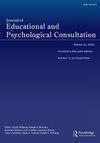学校-诊所合作促进公平和有效的自闭症鉴定
IF 1.1
4区 心理学
Q4 PSYCHOLOGY, EDUCATIONAL
Journal of Educational and Psychological Consultation
Pub Date : 2023-10-06
DOI:10.1080/10474412.2023.2262451
引用次数: 1
摘要
自闭症评估过程往往是碎片化的,导致准确识别和服务的延迟。在自闭症诊断过程中,这些低效的过程也给家庭带来了沉重的负担,因为自闭症诊断过程往往需要跨提供者和环境共享信息。学校、临床机构和社区之间的合作可以促进公平和有效地获得自闭症评估服务。来自少数群体和边缘化背景的儿童和家庭尤其能够从校医合作中受益。本文(1)强调了自闭症识别和系统在种族/民族/社会经济方面的低效率和不公平的现状;(2)比较了自闭症教育识别和临床诊断之间的过程、好处和挑战;(3)描述了学校-诊所合作过程如何解决这些系统的低效率和不公平问题;(4)展示了使用学校-诊所合作的模型示例。(5)为供应商提供具体建议。披露声明作者未报告潜在的利益冲突。注1关于语言/术语的说明:在本文中,我们交替使用个人优先和身份优先的语言。人们通常认为,以人为本的语言更有礼貌,减少了非人性化的语言,然而,人们普遍认为,被诊断为自闭症的人更喜欢以身份为本的语言,因为以人为本的语言会让人感到耻辱,比如指那些“与”诊断“斗争”的人。身份优先的语言也是一种表达对身份的自豪感的方式(Brown, citation, d.)。没有一个社区是铁板一块的,在个案的基础上尊重个人是很重要的。附加信息:切尔西快手切尔西快手,博士是丹佛行动行为中心的心理学家,是丹佛科罗拉多大学的教授。Megan E. Golson,博士,是佛罗里达州迈阿密梅尔曼儿童发展中心的博士后研究员。maryellen Brunson McClain博士,是印第安纳大学布卢明顿分校学校心理学项目的副教授。Jeffrey D. Shahidullah博士是德克萨斯大学奥斯汀分校戴尔医学院精神病学和行为科学系的助理教授。本文章由计算机程序翻译,如有差异,请以英文原文为准。
School-Clinic Collaboration to Improve Equitable and Efficient Autism Identification
ABSTRACTAutism evaluation processes are often fragmented and lead to delays in accurate identification and services. These inefficient processes also lead to substantial burden on families when navigating the autism diagnostic odyssey that often requires information-sharing across providers and settings. Collaboration across schools, clinical settings, and communities can facilitate equitable and efficient access to autism evaluation services. Children and families from minoritized and marginalized backgrounds are particularly positioned to benefit from school-clinic collaboration. This paper (1) highlights the current state of autism identification and systems inefficiencies and inequities along racial/ethnic/socioeconomic lines, (2) compares the processes, benefits, and challenges between educational identification and clinical diagnosis of autism, (3) describes how school-clinic collaboration processes can address these systems inefficiencies and inequities, (4) presents examples of models that use school-clinic collaboration, and (5) offers specific recommendations for providers. Disclosure StatementNo potential conflict of interest was reported by the author(s).Notes1 A note on language/terminology: In this paper we interchangeably use person-first and identity-first language. Person first language is generally thought to be more respectful and reduce dehumanizing language, however it is widely accepted that people who have received an autism diagnosis prefer identity-first language due to person-first language feeling stigmatizing, such as referring to someone who “struggles with” a diagnosis. Identity-first language is also a way to signify pride in one’s identity (Brown, Citationn.d.). No community is a monolith, and it is important to honor the individual on a case-by-case basis.Additional informationNotes on contributorsChelsea QuickChelsea Quick, PhD is a Psychologist at Action Behavior Centers in Denver, CO.Bryn HarrisBryn Harris, PhD is a Professor at the University of Colorado - Denver.Megan E. GolsonMegan E. Golson, PhD is a Postdoctoral Fellow at Mailman Center for Child Development in Miami, FL.Maryellen Brunson McClainMaryellen Brunson McClain, PhD, is an Associate Professor in the School Psychology Program at Indiana University - Bloomington.Jeffrey D. ShahidullahJeffrey D. Shahidullah, PhD, is an Assistant Professor in the Department of Psychiatry and Behavioral Sciences within Dell Medical School at University of Texas at Austin.
求助全文
通过发布文献求助,成功后即可免费获取论文全文。
去求助
来源期刊

Journal of Educational and Psychological Consultation
PSYCHOLOGY, EDUCATIONAL-
CiteScore
3.40
自引率
23.50%
发文量
20
期刊介绍:
The Journal of Educational & Psychological Consultation (JEPC) provides a forum for improving the scientific understanding of consultation and for describing practical strategies to increase the effectiveness and efficiency of consultation services. Consultation is broadly defined as a process that facilitates problem solving for individuals, groups, and organizations. JEPC publishes articles and special thematic issues that describe formal research, evaluate practice, examine the program implementation process, review relevant literature, investigate systems change, discuss salient issues, and carefully document the translation of theory into practice.
 求助内容:
求助内容: 应助结果提醒方式:
应助结果提醒方式:


